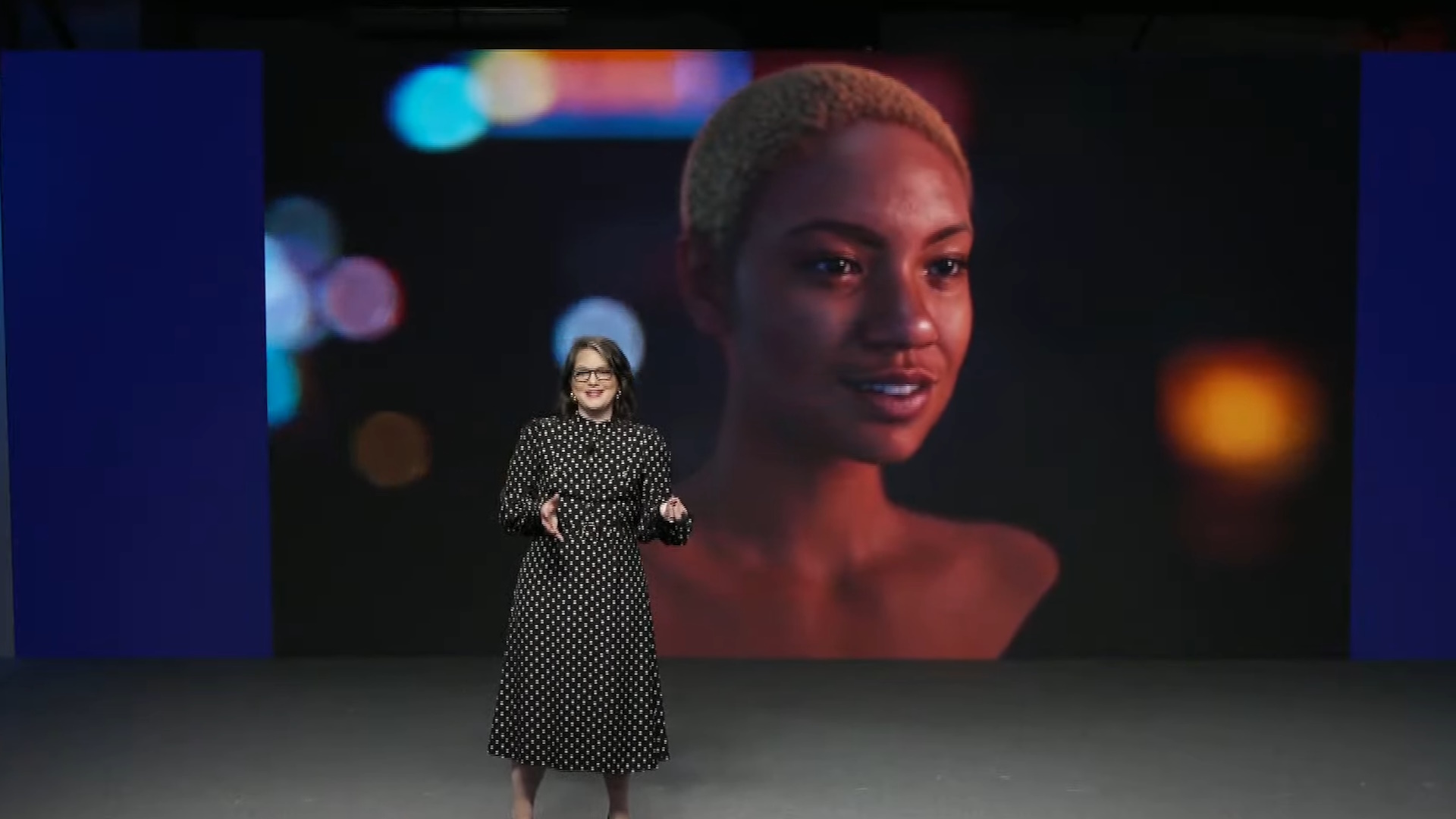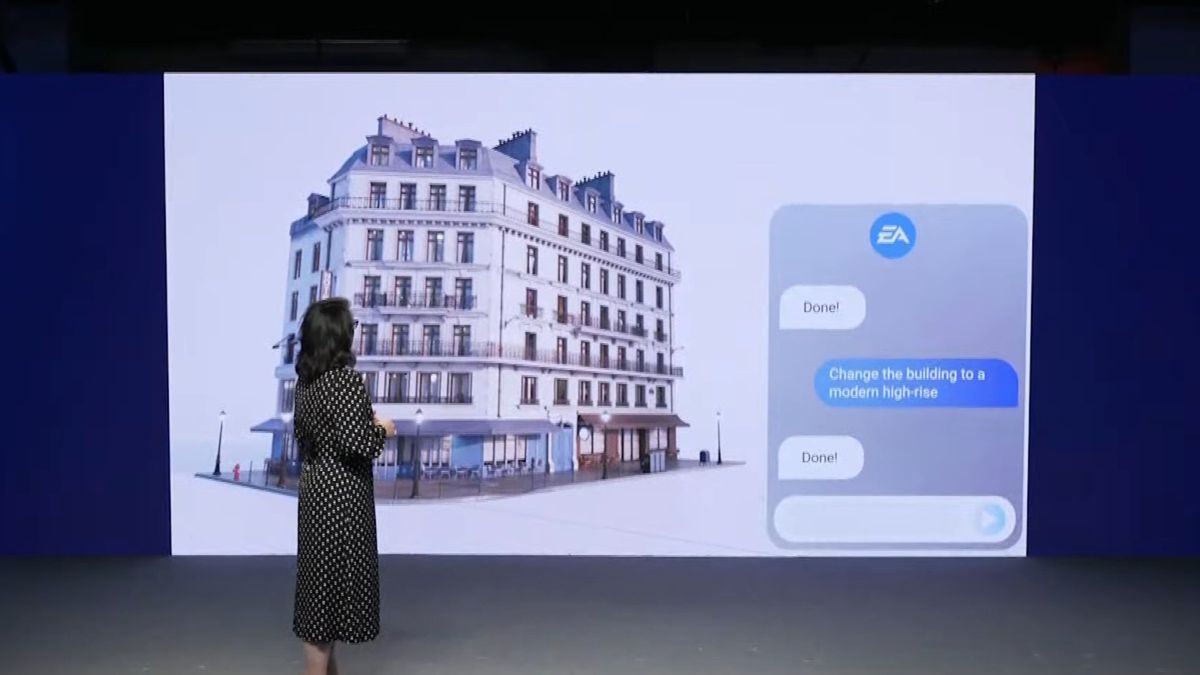EA gathered a whole bunch of executives and bean counters together for a lengthy Investor Day presentation today, September 17, much of which gave two big thumbs up to myriad forms of generative AI, an increasingly divisive topic in the games industry and a driving reason behind the video game actor strike.
“AI in its different forms has always been central to this creative journey,” begins EA CEO Andrew Wilson. “We all remember playing against the AI. And it has evolved into today’s innovations in generative AI. This remarkable technology is not merely a buzzword for us – it’s the very core of our business.”
Wilson correctly points out that AI is, and has been, fundamental to many aspects of game development and logic, then quickly goes all-in on generative AI specifically. Some fundamental elements of EA’s vision, like leveraging AI as a tool to be held by human hands, have seen support across the industry, but the publisher’s approach seems a bit heavier-handed compared to the likes of Nintendo or even Sony.
“Right now we have over 100 active novel AI projects across three strategic categories: efficiency, expansion, and transformation,” Wilson explains, diving right into efficiency. “This does not just mean cost savings today. Efficiency is doing what we’re doing today faster, cheaper, and at a higher quality. That means driving more iteration, more testing, and higher quality content for our community. It means removing obstacles for our game developers. It means culturalizing content across geographies so they can focus on finding more fun for more players around the world.”
“The lowering of these friction points leads to deeper gameplay experiences,” he continues. “For example, we would not have created the smash hit College Football 25 without AI. That’s how 150 unique stadiums and over 11,000 player likenesses are in the game.” Again, this College Football example parallels one of the more popular or at least widely embraced applications of AI: let humans use it to speed up a job that humans don’t need to do. It’s that boundary, what needs a human touch, that gets a bit blurry in EA’s full-throated AI roadmap.
“Expansion is about giving our creative team an exponentially bigger canvas upon which to create, and richer colors so they might paint more brilliant worlds,” Wilson espouses. “It’s about our incredible teams creating characters with more depth and intelligence, telling stories that are more personal and nuanced, and bringing more authenticity and deeper immersion to our already unrivaled sports experiences.” Fellow AAA publisher Ubisoft has similarly talked up AI-powered NPCs, often with strange results.
“We believe AI will greatly expand and transform the entertainment experience for user-generated content,” Wilson concludes. “It will accelerate how innovators and creators in entertainment are building and delivering experiences rooted in self-expression, content creation, curation, and instant gratification – the kind of entertainment that today’s players and fans deeply crave.”
The mic is then passed to Laura Miele, president of EA entertainment and technology, who revisits AI and generative AI later in the presentation. “We cannot talk about technology without talking about AI,” she reckons. Miele also brings some color to Wilson’s earlier claim: “Today our team manages over 100 machine learning and large language models on the central platform.” The shape and output of these systems is the focus of a section on SEED, or the Search for Extraordinary Experiences Division, and a shared asset library tethered to many AI initiatives.
The two key questions with AI, Miele says, are these: “How will it benefit our players’ experience? And how will it enable our developers to do their very best work?” To answer them, she points to EA’s Frostbite engine, “which only gets more powerful when paired with our shared data.”
“We are in a multi-year effort to centralize decades of high quality 3D data and assets,” she explains. “This library is like the Smithsonian of game assets. They are fully curated, labeled, and exclusive to our teams. This provides our developers with a wealth of content that allows for rapid prototyping, but also game-ready assets they can quickly modify to go directly in their games.”
Again, a lot of this sounds like some of the more accepted upsides and purposes of AI in the games industry. In fact, this section, in particular, is pretty normal game engine stuff – access to assets which can, at the very least, serve as a ready-made basis for prototyping. It’s the relationship between this asset library and the aforementioned SEED initiative that may raise eyebrows among the less AI-hungry.

“This library also serves another essential purpose in that it educates our machine learning and large language models with our proprietary data, and as you would imagine this has become more and more critical in this new age of AI,” Miele adds.
“This group of researchers, PHDs, and data scientists are focused on areas such as AI-enabled game development, generative arts, and procedural content to push the boundaries of what is possible in interactive experiences,” Miele says of SEED. “One of the exciting projects they’re working on is called Script to Scene. This initiative aggregates multiple workflows to create a powerful tool for developers to create characters, direct performances, and define worlds all from text.”
This is where the wheels on this presentation really threaten to lose their grip on the tracks. In a video demonstration showing how this Script to Scene project can turn prompts into assets or even experiences, which does notably have a disclaimer that it “depicts early-stage concept only,” EA briefly shows off a female character (above) who can purportedly be generated “from just a photo” and then animated and rigged “using just a voice.”
The crown jewel of this presentation is a demonstration on AI-generated buildings. Miele, loosely keeping pace with a video showing a chatbot-esque exchange between a user and an AI interface, requests a Parisian apartment building. Poof! A building appears on-screen. “I don’t know, let’s maybe make it taller,” she asks. And lo, the building gets taller. “Let’s do a modern high-rise building,” she says, at which point this AI – rather, this video example of AI – spits out a bizarre amalgamation of uneven, amorphous floors covered in random white external walls that look like concrete scaffolding.
“Zooming out even further, the technology can extend to neighborhoods, cities, and eventually worlds that populate gaming environments, instantaneously,” Miele says. “If you add to these workflows procedural performance direction, intelligent agents, you get this amazing collection of AI-generated actions that culminate into a scene from a simple text or voice prompt.”
EA doubles down, stopping just short of pouncing on the phrase that is the dream of every AAA investor: Computer, make me a video game. You could argue that this kind of moonshot proposal is exactly what stirs up the AI “buzzword” discourse Wilson alludes to.











